
Network attached storage (NAS) devices have the ability to protect and store critical data at high-performance speeds.
For years, defense and aerospace organizations installed direct attached storage (DAS) in deployed vehicles. However, as storage needs increase and Ethernet has become commonplace in mission vehicles, NAS solutions have become an essential option for data storage. When a NAS device is used, the stored data can be made available to all devices and computers on the Ethernet network, not just a single computer.
A NAS device will have three basic sections or subsystems – input/output (I/O), a central processor unit (CPU), and memory (MEM). By definition, a NAS device connects to an Ethernet network providing remote data storage to the network clients.
That Ethernet network may operate at one gigabit per second (1 GbE), ten gigabits per second (10 GbE), or higher (40 GbE, 100 GbE). The selection of the Ethernet speed of the network depends on the clients and how much data they are expected to store on and retrieve from the NAS. In a deployed vehicle, network clients may be mission computers, sensor management computers, streaming cameras, radars, sonars, or other devices that collect or manage data.
1 GbE Example NAS
If the clients are all 1 GbE based, then a NAS like that shown in Figure 2 may be used. The example 1 GbE NAS has two 1 GbE ports and is designed to fit into very small spaces on deployed vehicles. Its throughput speed is limited by the combination of the I/O (2 x 1 GbE ports), the CPU (1 ATOM processor), and the MEM (1 SATA solidstate drive or SSD). Also, encryption mechanisms inside the example 1GbE NAS affect the throughput.

Gigabit Ethernet has an actual line rate of 1,250 megabits per second (Mb/s). Because it uses 8b/10b encoding, the effective line rate is 1,000 Mb/s. Dividing 1,000 Mb/s by 8 bits per byte gives a theoretical byte rate of 125 megabytes per second (MB/s). Other factors like switch efficiency and network congestion may affect actual data transfer.

